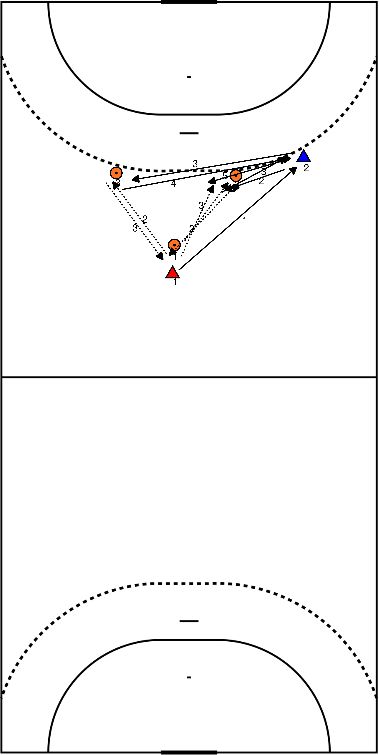Handball drills for technique attack / offense
- This describes a system where the builders run a switch.
- The circle runner decides on which side the substitution will be made.
- If the circle runner is on the right side of the middle defender, the substitution is also made on the right.
- The middle constructor has the ball and gives a pass to the right constructor.
- The middle constructor, after playing the ball to the right constructor, puts a bar on the defending second constructor.
- The right hand builder goes behind the middle builder and ends up in the middle.
- The left-hand builder goes behind the right-hand builder again.
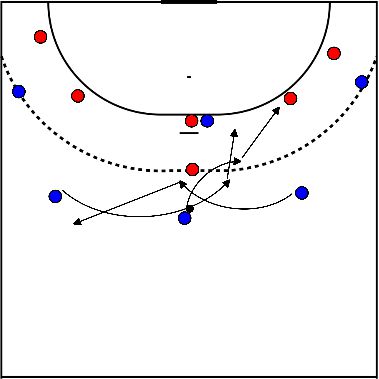
- This exchange takes place between circle runner.
- And the corner players.
- The circle runner moves without the ball from the middle to the side and puts a barrier on the defending corner player.
- The attacking corner player has the ball at that moment and can make use of the obstruction.
- Or pass the ball to the set-up player
- Who then passes the ball on to the half-career player and so on
- The attacking corner player who passed the ball on to the attacker "runs with the ball" inside the 9m, slowing down a little.
- He or she then comes between defender 2 and 3 towards the goal again and may receive the ball from the up-and-comer who has already received it at that point.
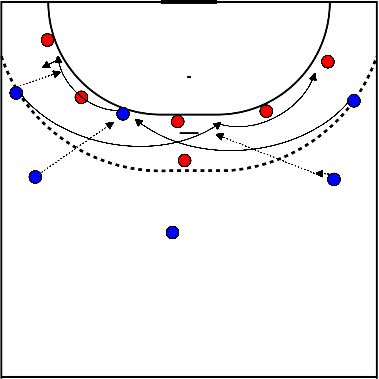
- You make pairs.
- Both persons stand on the circle at the same height as the poles.
- You run with 1 ball per pair to the other side of the circle.
- While running to the other side you throw the ball to each other.
- When you're on the other side you run back to the other side.
- Variation:
- Overhand throw.
- Knee-down passing.
- Passes with jump shot.
- Sideways jump to the opposite circle.
- Cross pass to the opposite circle.
- Accelerated pass. (50, 60, 70, 80 %)
- Sprint.
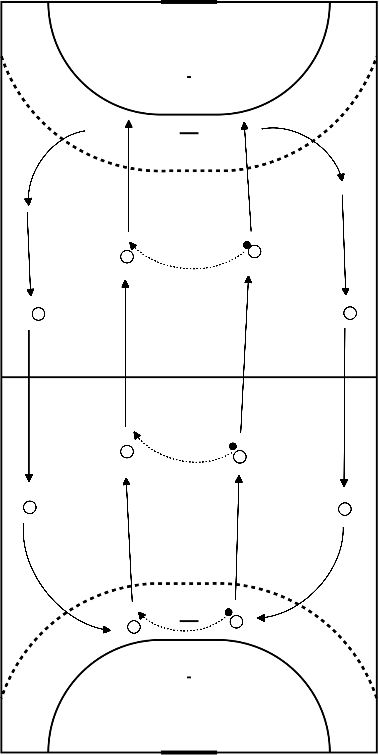
- First practise starting and throwing in the goalkeeper.
- Then cross.
- Player A plays to player B and runs around it.
- Gets the ball from player C.
- Player C runs around player B and gets the ball from him.
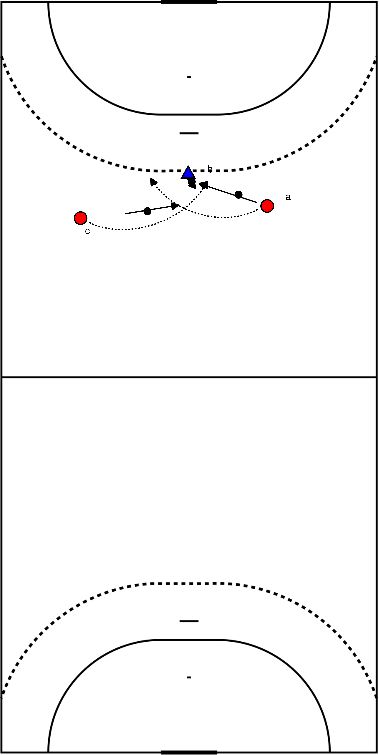
- Divide the groups into builders and corner players.
- The builders position themselves in the middle and the corner players on the left and right.
- Set-ups will practise the running shot
- There is 1 point of attack (alternates) who you play to.
- You receive the ball in the run and finish with a running shot
- It is important that you get the ball in the top corner and keep on running
- In this way, you can surprise the defence with your shot
- Do not take 3 big steps towards the run first, but keep to the rhythm of your run
- When you have fired your shot, walk through and bend your upper body slightly forwards.
- With this shot, it often happens that you stand with your wrong leg in front, this does not matter.
- The corner players will be working with various feints
- 1 feint for an outside pass and 1 feint between 1 and 2
- The ball is played to a corner player who feints an inward or an outward move (of your own choice, but alternate)
- There is a passive defender who, after a few times, starts to defend more and more
- It is important that you pressure the inside (or outside) and then quickly go around it
- You can also do this with a turn
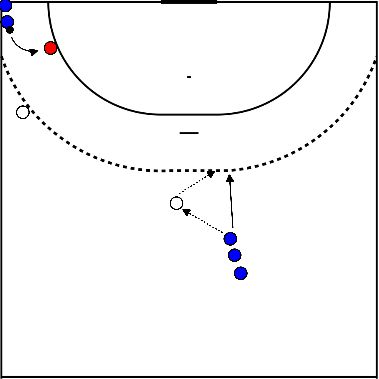
- Right corner player runs towards the outside defender on the other side and puts a back barrage.
- Left build-up with ball threatens on the 2nd defender.
- Makes a threat and jumps to the middle and plays to the blocking player or shoots at goal himself
- Optionally, the ball can also be played into the circle if the middle defender gets out/closes up.
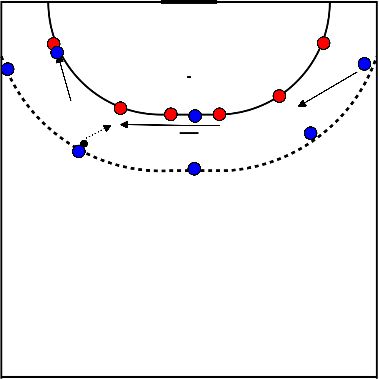
- 2 teams divided over the right and left corner.
- 1 defender between the halfway line and the 9 meter who tries to intercept.
- One of the teams passes to the goalkeeper.
- The goalkeeper plays one of the team around the halfway line.
- The duo tries to outplay the attack and scores on goal.
- After scoring, grab the ball and stay on that side.
- The same is done on the other goal.
- As a variation, you can put 2 defenders down to make it more difficult.
- You can make it more difficult by telling them they cannot bounce.
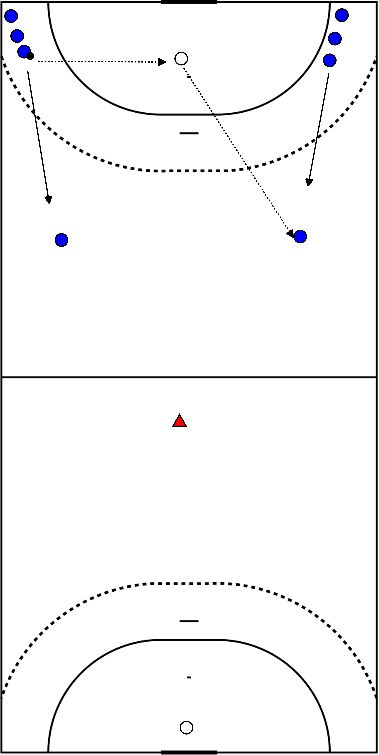
- Put a goal or put a mat in front of it and make compartments with tape or in some other way.
- Give the divided squares points.
- Each player may throw 3 times.
- Keeping track of the points and adding them up
- Player starts at the pylon in the middle.
- Sprints to the left pylon.
- Picks up the ball and works it towards the goal.
- Player sprints back to the pylon in the middle.
- Now sprints to the right pylon.
- Picks up the ball and finishes on the goal.
- Player sprints back to the centre pylon.
- Sprints to the second pylon on the left.
- Finishes with the goal.
- Player sprints back to the centre pylon.
- Sprints to the second pylon on the right.
- Finishes with the goal.
- The other players remain in their places, dribbling
- Or they can do strength training
- Jumping rope
- Dribble with the ball in a square.
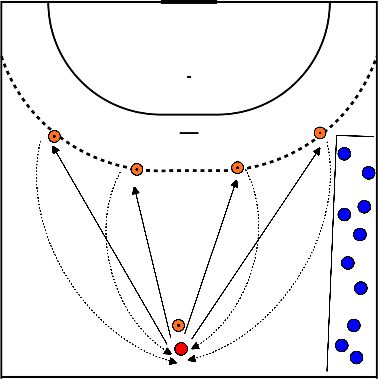
- Ball goes from the left tackle to the middle tackle.
- The middle build-up breaks away and throws the ball to the incoming corner.
- The corner starts to receive the ball and puts pressure on the defender. (threatening the goal)
- The build-up puts pressure on the middle and rounds off. (jump shot)
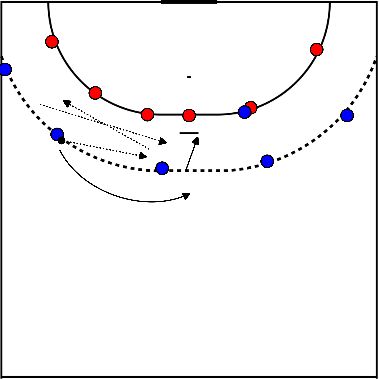
- A normal game is played, however with a special rule.
- Everything remains the same, teams of 7 (6 field players + 1 goalkeeper) are made.
- As a team in a break-out.
- In a first or in a second phase they make a goal they may attack again.
- If they have scored in this way they may break out again at the centre builder.
- If a goal is scored in this attack, they have made 2 points in 1 attack.
- If they don't score, it's only 1 point.
- This continues until time is up.
- Change:
- You can also choose to reward a break-out.
- You can also choose to reward a break-out, first or second phase attack with 2 points instead of a new attack.
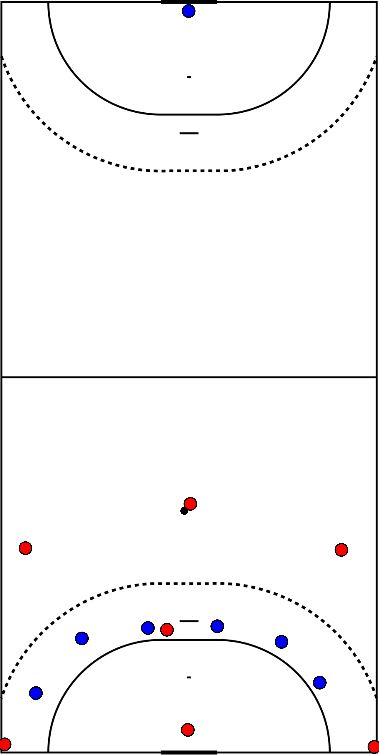
- 2 teams of 5 - 6 players.
- The exercise is performed as a relay race.
- The team runs a slalom around the pylons.
- The point from which the throw must be made is at the pylon at the free throw line.
- The moment the player finishes, the next player starts.
- Variations:
- The whole round is dribbled
- Each player makes 3 rounds:
- The first round the ball is carried between the pylons and dribbled along the long side
- The last round is the whole round dribbled.
- Carry the ball between the pylons and dribble the rest of the way
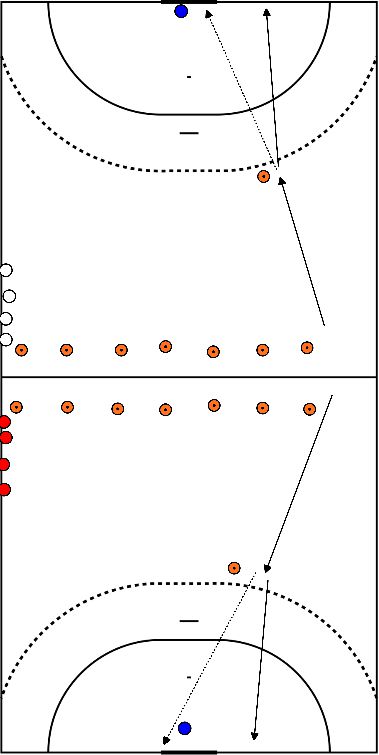
- Player 2 plays the ball to player 1 and walks to pawn 2
- Gets the ball from player 1 again
- Plays the ball back to player 1 and walks backwards around cone 1
- Runs to pylon 3 and gets the ball from player 1
- Plays the ball back to player 1 and walks backwards around cone 1 to the middle between cones 2 and 3
- Gets the ball in the path of player 1.
- Finish on target.
- Everything on fast tempo.
